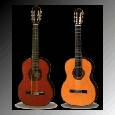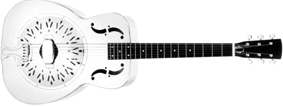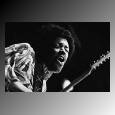

Home | UK Festivals | Dental Amalgam | Chess & Draughts | Design
Brief History of the Guitar
History of the Guitar - Present
 |
A look at the history of
this beautiful instrument and its development over the
last few centuries. The outstanding depth of expression, range of sounds and versitily of the guitar as both a classical and contemporary instrument has undoubtedly contributed to its worldwide rise in popularity. Fundamentally consisting of vibrating strings around a wooden box, what we now recognise as a guitar developed as late as the 19Cen. |
Distant relations of the guitar include lyres and harps (mentioned in the New Testament) and long necked lutes fo Mesopotamia. Evidence of stringed instruments has also been found in Egyptian paintings and three thousand year old Hittite carvings in Turkey. Instruments very similar to the guitar are also depicted in medieval literature, paintings, carvings and stained glass windows and was very popular in Spain during the Renaissance(14-16 cents). During the time of Christopher Columbus, it was taken to South America and is now popluar in Mexico, Venezuela, Brazil and Argentina
| In the 16 cent printed music for guitar-like instruments first became published (example). The types of instruments used at the time consisted mainly of the Vihuela,Lute and Guitarre, usually accompanied by bagpipes, Pan pipes, harps, drums, fiddles and hurdy-gurdies. These instruments were strung in pairs, known as "courses" which gave a significantly different sound to the single stringed guitar. In 16 Cent. Spain, the vehuela was more popular than the lute, wheras most European countries of this time preferd the Lute. |  |
 |
Lute There are significant structural differences between the guitar and lute. With its pear shaped back and lighter construction, the lute produces a light, brilliant sound with less ressonance than the guitar. It also usually has more strings. In England at the time of queen Elizabeth I, one of the most noted lute players waa John Downland. During the Renassiance, more strings were added to the lute, making tuning complicated and maintenance expensive. |
Veuhela A considerable amount of music was published for the vihuela between 1535 and 1578. This more closely resembles the guitar in shape and tuning. Indeed, the modern guitar could be said to originate from it.
 |
 |
 |
The smaller four course Guitarra became very popular with the Spanish people. It also came in to widespread use in France under the influence of Henri II, king of France. It was considered easier to play than the veuhela and the Venezuelan "Cuatro" and Columbian "tiple" are its likely descendants. Francesco Corbeta (Italy, 1615-1681) was a most noted guitarist of the time. He performed in English courts became guitar instructor to the French royal family. No more music was produced for the vehuela after 1578, (For more info on the guitarra see LINK) |
By the 18 cent, the lute is far less evident. At about the same time, the guitar developed the single strings, the preferred stringing method in use today. The six stringed guitar became extremely popular at the time of Napoelon.
The early 19 cent. saw alterations to the guitars' construction. The vibrting string length (the distance from the bridge to the nut) was not considered to be optimum. To rectify this and to increase its expressive quailties, Antonio de Torres Jurado (1817-1892) made several changes to the guitars' design. He increased the string length from 60 - 65 cm to enhance volume, tone production and ease of playing and changed the body of the guitar, making it deeper, altering its shapes and curves and emphasised the importance of the quality of the "tapa" (front of the guitar) for tonal excellence.
 |
Over time, the size, shape, stringing and tuning have been developed to produce the wonderful expressive qualities found in the modern guitar. This development was too late, however, for the guitar to feature in the compositions of Bach, Mozart, Mendelsson,Chopin and Schumann. |
Terraga was the first to use fretted notes at higher positions in preference to open srtings and to combine fretted notes with open strings to enhance variety of expression. He developed the use of a footstool and considerd that the common practice of resting the little finger on the front of the guitar to be detrimental to the fluency of the right hand and so developed a style of playing with the right hand free, unsupported by the little finger. This is still the accepted playing method of today.
Improvements in guitar design led to changes in playing techniques thanks to the skill of such great musicians as Francisco Terraga (1852-1909) and Andres Segoovia(1893-*). Segovia is considerd by some to be the father of the modern classical guitar. His pieces included transcriptions of Bach and Terraga, amongst others. Some claim that because of Segovia's influence the guitar became accepted into the world of classical music and established as a solo instrument. The advent of Nylon strings at this time allowed the guitar to produce much more consistent tones, while also being able to project the sound much farther.
At the same time as Segovia, in the Southern states of the USA, jazz musicians were discovering the worth of the guitar in a band's rhythum section. The guitar became modified for jazz with addition of steel strings and strenghtened structure and played with a plectrum to give more percussive presence.
Jazz guitar

Musicians such as Eddie Lang (1902-1933) and Charlie Christian (1916-1942) developed the method of "lead breaks", using single string improvisation. Benny Goodman Big Band and Sextet amplifiied the guitar. Django Reinhardt (1910-1953) brought the worlds attention to jazz guitar when he played with the violinist Stephane Grappelli.
 Since
then we have enjoyed the developments in jazz music
fuelled by the talents of the likes of Herb Ellis, Kenny
Burrell and of course Jimi Hendrix (1942-1970). Since
then we have enjoyed the developments in jazz music
fuelled by the talents of the likes of Herb Ellis, Kenny
Burrell and of course Jimi Hendrix (1942-1970). |
Home | UK Festivals | Dental Amalgam | Chess & Draughts | Design
If you would like to contribute or comment on this site, you can e-mail me: lyle99@hotmail.com